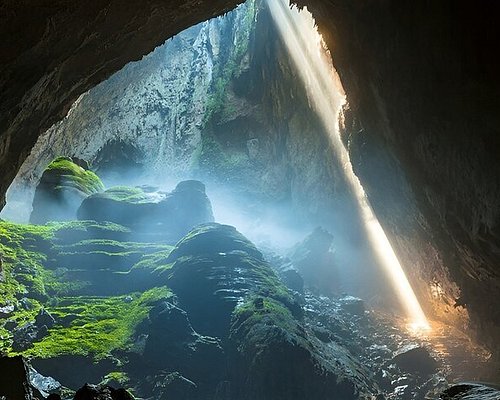Phong Nha-Ke Bang National Park, one of the most breathtaking places in Southeast Asia, is situated in Quang Binh Province in central Vietnam and is recognized as a UNESCO World Heritage Site. Nature enthusiasts, adventurers, and explorers will find heaven in the park, which is well-known for its breathtaking limestone karst landscapes, vast cave systems, and abundant wildlife. Here is a thorough overview of Phong Nha-Ke Bang National Park to assist travelers in making travel plans.
1. Overview
- UNESCO Recognition: Phong Nha-Ke Bang was recognized as a UNESCO World Heritage Site in 2003 for its geological significance and biodiversity. It was later expanded in 2015 to include its incredible ecological and biological diversity.
- Area: The park spans over 123,326 hectares, featuring limestone mountains, tropical forests, underground rivers, and caves that are millions of years old.
- Significance: The park is home to some of the world’s largest and most spectacular caves, including the record-breaking Son Doong Cave, the largest cave on Earth.
2. Iconic Attractions
Phong Nha-Ke Bang offers a variety of attractions that cater to all types of travelers, from casual tourists to hardcore adventurers.
a. Son Doong Cave
- World Record: Son Doong Cave is the largest cave in the world, with a height of up to 200 meters and a width of 150 meters. Its vast chambers even have their own climate, jungle, and river.
- Adventure: Exploring Son Doong is a bucket list experience, but it requires a guided expedition due to its complexity and environmental protection measures.
b. Phong Nha Cave
- Accessibility: This cave is one of the most famous and easiest to explore. Visitors take a scenic boat ride along the Son River to reach the entrance.
- Features: Known for its stunning stalactites and stalagmites, the cave also has ancient inscriptions and underground rivers.
c. Paradise Cave (Thien Duong Cave)
- Length: Stretching over 31 kilometers, Paradise Cave is one of the longest dry caves in Asia.
- Highlights: The cave is renowned for its awe-inspiring rock formations, including stalactites and stalagmites that resemble sculptures.
- Accessibility: A wooden walkway makes it easy for visitors to explore the first kilometer of the cave.
d. Dark Cave (Hang Toi)
- Adventure Activities: This cave offers a mix of adventure and fun, including ziplining, kayaking, and swimming in its underground river. Visitors can also enjoy a mud bath inside the cave.
- Family-Friendly: It’s a great spot for those seeking a more interactive and adventurous experience.
e. Tu Lan Cave System
- Multi-Day Treks: This system of caves requires trekking, swimming, and camping, making it ideal for those looking for an off-the-beaten-path adventure.
- Scenery: The area is surrounded by lush jungles, waterfalls, and rivers.
3. Biodiversity
Phong Nha-Ke Bang National Park is not just about caves; it is also a haven for wildlife and plants.
- Flora: The park is home to over 2,500 plant species, many of which are rare or endemic.
- Fauna: It hosts over 140 mammal species, including endangered animals such as the Asiatic black bear, Indochinese tiger, and sarus crane. Birdwatchers can also spot over 300 bird species.
- Ecosystem: The park features both tropical evergreen forests and limestone karst ecosystems, making it one of the most biodiverse areas in Vietnam.
4. Activities for Tourists
Phong Nha-Ke Bang offers a variety of activities for visitors of all ages and fitness levels.
a. Cave Exploration
- Whether you prefer easy boat tours or challenging expeditions, the park has caves for every level of adventurer.
b. Trekking and Hiking
- Trails through the national park offer stunning views of limestone mountains, dense forests, and waterfalls. Popular trails include the trek to Hang En Cave and the Botanic Garden.
c. Kayaking and Ziplining
- The Chay River and Dark Cave are ideal for kayaking and ziplining. These activities combine adventure with scenic views.
d. Wildlife Watching
- Join eco-tours to spot rare animals and birds in their natural habitat.
e. Cycling
- Rent a bike and explore the peaceful countryside surrounding the park, where you’ll find rice paddies, small villages, and friendly locals.
5. Local Culture
Phong Nha is surrounded by charming rural villages where you can experience authentic Vietnamese culture.
- Homestays: Stay with local families to learn about their traditions and daily life.
- Cuisine: Enjoy local specialties like grilled pork skewers, banh xeo (Vietnamese pancakes), and freshwater fish.
- Festivals: If you visit during traditional festivals, you can witness unique cultural performances and ceremonies.
6. Best Time to Visit
- Dry Season (March to August): Ideal for cave exploration and outdoor activities, as the weather is warm and dry.
- Rainy Season (September to November): While some caves may close due to flooding, the park’s lush greenery is at its peak.
- Cool Season (December to February): The weather is cooler, making it perfect for trekking and hiking.
7. Tips for Tourists
- Book in Advance: Popular cave tours, especially to Son Doong, require early booking.
- Wear Comfortable Clothing: Sturdy shoes and lightweight, breathable clothing are essential for trekking and cave exploration.
- Respect the Environment: Follow all park rules to preserve its natural beauty. Avoid littering and touching cave formations.
- Stay Hydrated: Bring plenty of water, especially during outdoor activities.
- Hire a Guide: Local guides can enhance your experience by sharing insights about the park’s history, geology, and culture.
–>Anyone looking for exciting activities, natural wonders, and cultural encounters should make time to visit Phong Nha-Ke Bang National Park. The park provides a singular and remarkable experience into the core of Vietnam’s natural heritage with its unmatched cave systems, verdant landscapes, and abundant species. Phong Nha-Ke Bang promises an experience unlike any other, whether you’re kayaking down underground rivers, hiking through the jungle, or taking in the world’s largest cave.


Comment (0)